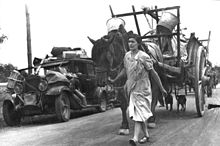The Exodus (1940)

The Exodus (French: l'Exode) refers to was a massive flight of Belgian, Dutch, Luxembourgish, and French populations in May – June 1940 when the German army invaded Belgium, the Netherlands, and the majority of French territory during the Battle of France, after the breakthrough at Sedan. This exodus is one of the largest refugee crisis in the French history, and also one of the largest population movements of the 20th century in Western Europe.[1][2]
During the summer of 1940 and in the following months, the French had to deal with millions of civilian refugees fleeing the war. Automobiles and horse-drawn carts carrying possessions clogged roads. As the government had not foreseen such a rapid military collapse, there were few plans to cope. Between six and ten million French fled, sometimes so quickly that they left uneaten meals on tables, even while officials stated that there was no need to panic and that civilians should stay. The population of Chartres dropped from 23,000 to 800 and Lille from 200,000 to 20,000, while cities in the south such as Pau and Bordeaux rapidly grew in population.[3]
See also[edit]
References[edit]
- ^ Diamond, Hanna (2008). Fleeing Hitler: France 1940. Oxford: Oxford University Press. pp. 10–12. ISBN 978-0-19-162299-1.
- ^ Risser, Nicole Dombrowski (2012). France under Fire: German Invasion, Civilian Flight and Family Survival during World War II. Cambridge: Cambridge University Press. pp. 207–209, 285. ISBN 978-1-139-53696-7.
- ^ Jackson, Julian (2001). France: The Dark Years, 1940-1944. Oxford: Oxford University Press. pp. 119–120. ISBN 0-19-820706-9. OCLC 45406461.
Further reading[edit]
- Alary, Éric (2013). L'exode un drame oublié (in French) ([Nouvelle édition augmentée] ed.). Paris: Perrin. ISBN 978-2-262-04312-4. OCLC 863605969.
- d'Avout, Aurélien (2023). La France en éclats. Écrire la débâcle de 1940, d’Aragon à Claude Simon (in French). Bruxelles: Les Impressions Nouvelles. ISBN 978-2-39070-025-8.
- Catros, Simon; Wilkin, Bernard (2022). "Sur les chemins de l'exode : les réfugiés belges dans l'Eure, 1940:". Histoire, économie & société. 41 (1): 57–73. doi:10.3917/hes.221.0057.
- Catros, Simon (2021). "L'exode dans l'Eure : accueillir, partir, revenir (printemps 1940-printemps 1941):". Annales de Normandie. 70 (2): 145–178. doi:10.3917/annor.702.0145.
- Gotovitch, José (2016). "L'exode de Belgique". In Martens, Stefan; Prauser, Steffen (eds.). La guerre de 1940 : Se battre, subir, se souvenir. Villeneuve d'Ascq: Presses universitaires du Septentrion. pp. 103–110. ISBN 978-2-7574-1429-3.
- Lagrange, Maurice (1977). "Le rapatriement des réfugiés après d'exode (juillet-septembre 1940)". Revue d'histoire de la Deuxième Guerre mondiale. 27 (107): 39–52. ISSN 0035-2314. JSTOR 25728861.
